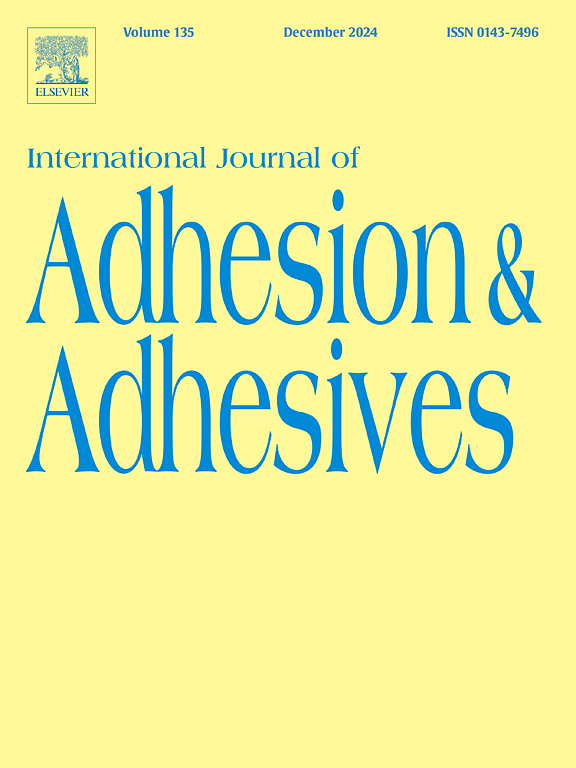Monotonic and fatigue flexural bond strength of CAD-CAM lithium disilicate and resin composites repaired with direct resin composites
IF 3.5
3区 材料科学
Q2 ENGINEERING, CHEMICAL
International Journal of Adhesion and Adhesives
Pub Date : 2025-07-15
DOI:10.1016/j.ijadhadh.2025.104102
引用次数: 0
Abstract
Objective
To evaluate the flexural bond strength of CAD-CAM lithium disilicate (LD) and resin composite (RC) repaired with different direct resin composites.
Materials and methods
LD and RC blocks were sectioned (6 × 6 × 6 mm). LD was crystallized, and after, both materials were ground with a fine-grit diamond bur. LD blocks were etched with 5 % HF acid followed by silane application. RC blocks were air-abraded with Al2O3. A universal adhesive system was applied to both substrates. The blocks were repaired with nanohybrid (NANOH), bulk-fill (BULK), or flowable (FLOW) resin composite up to 6 mm additional length, and then cut into beams (1 × 2 × 12 mm). After storage in distilled water at 37 °C for 24 h, a flexural bond strength test was run with the ball-on-hole approach (10 mm span, 2 mm diameter) under monotonic (0.5 mm/min, n = 10) or cyclic fatigue (for LD/RC respectively: initial load 5/10 N; step size: 2.5/5 N, 10,000 cycles for each step, 1.4 Hz, n = 15). Finite element analysis was employed to calculate bond strength (MPa), and the data were statistically analyzed (α = 0.05).
Results
For repaired LD, LD-FLOW showed the highest bond strength values. Higher occurrence of premature failures was seen at LD. Among the repaired RC, RC-BULK and RC-FLOW exhibited the highest values in monotonic testing, meanwhile RC-FLOW alone achieved the highest results in fatigue testing.
Conclusion
When repairing CAD-CAM LD or RC, better bond strength is achieved using a flowable resin composite. The high incidence of premature failures in LD raises questions to the repair longevity.
用直接树脂复合材料修复CAD-CAM二硅酸锂与树脂复合材料的单调和疲劳弯曲结合强度
目的评价不同直接树脂复合材料修复CAD-CAM二硅酸锂(LD)与树脂复合材料(RC)的弯曲结合强度。材料与方法将ld和RC块切片(6 × 6 × 6 mm)。将LD结晶,然后用细粒度金刚石研磨两种材料。用5%氢氟酸蚀刻LD块,然后应用硅烷。用Al2O3对钢筋混凝土砌块进行气磨处理。通用粘合剂系统应用于两种基材。砌块用纳米杂化(NANOH)、散装填充(BULK)或可流动(FLOW)树脂复合材料修复,再增加6 mm的长度,然后切割成梁(1 × 2 × 12 mm)。在37°C蒸馏水中储存24 h后,在单调(0.5 mm/min, n = 10)或循环疲劳(LD/RC分别为初始载荷5/10 n;步长:2.5/5 N,每步10000次循环,1.4 Hz, N = 15)。采用有限元法计算粘结强度(MPa),并对数据进行统计学分析(α = 0.05)。结果修复后的LD- flow黏结强度最高。在修复后的RC中,RC- bulk和RC- flow在单调试验中表现出最高的值,而RC- flow单独在疲劳试验中表现出最高的值。结论在修复CAD-CAM LD或RC时,使用可流动树脂复合材料可获得更好的粘结强度。LD中过早失效的高发生率引发了对其修复寿命的质疑。
本文章由计算机程序翻译,如有差异,请以英文原文为准。
求助全文
约1分钟内获得全文
求助全文
来源期刊

International Journal of Adhesion and Adhesives
工程技术-材料科学:综合
CiteScore
6.90
自引率
8.80%
发文量
200
审稿时长
8.3 months
期刊介绍:
The International Journal of Adhesion and Adhesives draws together the many aspects of the science and technology of adhesive materials, from fundamental research and development work to industrial applications. Subject areas covered include: interfacial interactions, surface chemistry, methods of testing, accumulation of test data on physical and mechanical properties, environmental effects, new adhesive materials, sealants, design of bonded joints, and manufacturing technology.
 求助内容:
求助内容: 应助结果提醒方式:
应助结果提醒方式:


